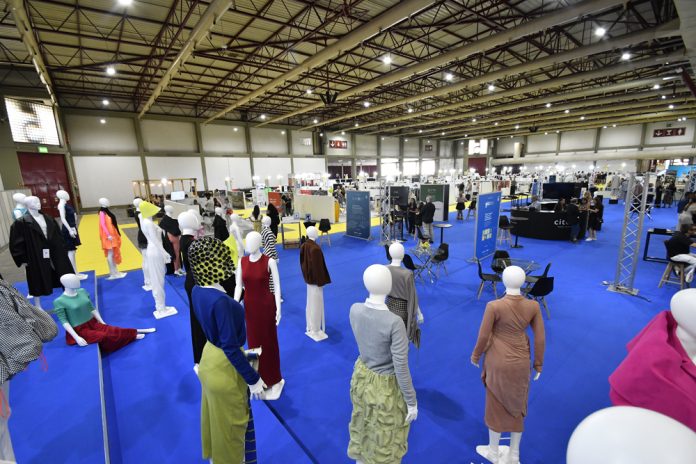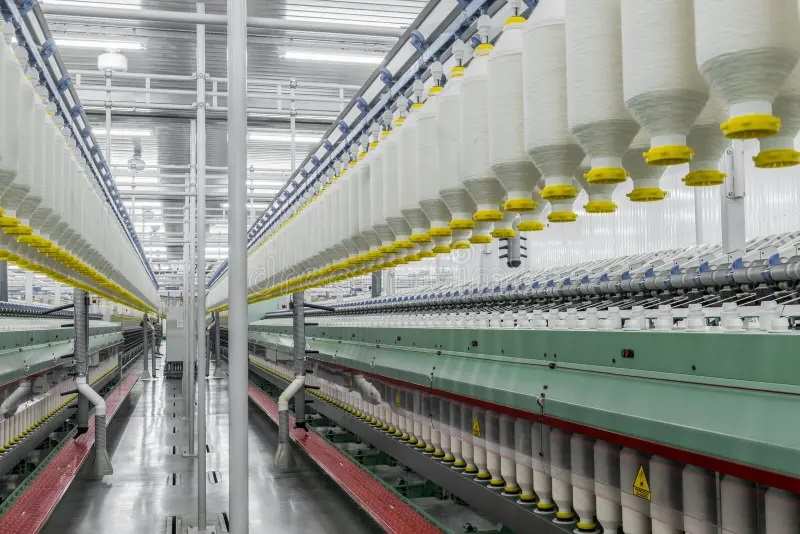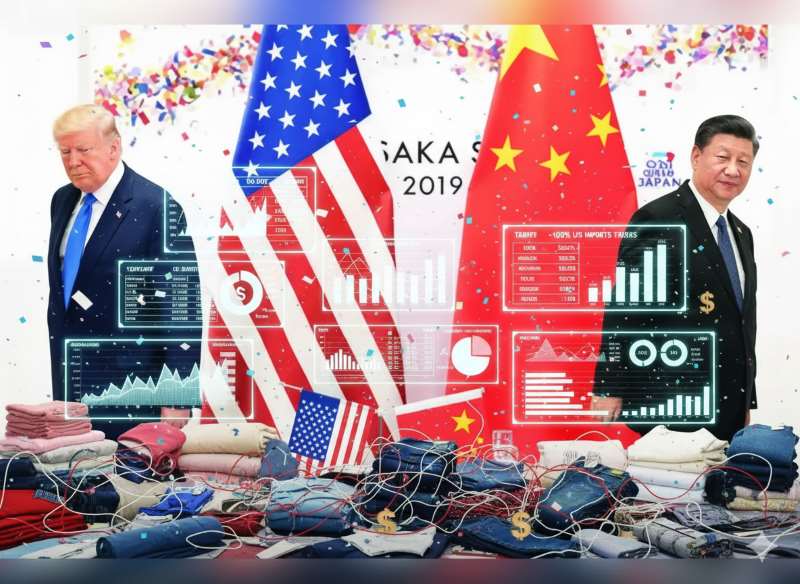FW
Successful launch of MOD'Unica
The inaugural edition of MOD'Unica, the textile fair organized by ATP - Textile and Clothing Association of Portugal with Spormex's support, gathered around 100 exhibitors on February 26-27 at Exponor’s Pavilion 1. The event established itself as a key meeting point for Portugal’s textile industry, attracting 3,500 visitors, including over 110 international attendees. The fair featured 300 collections and showcased more than 150 materials in its Trends Forum.
Organizers expressed gratitude to all participants, recognizing the collective effort that demonstrated resilience and confidence. They emphasized their commitment to strengthening partnerships with various entities and municipalities to enhance future editions.
AICEP’s support and industry transformation
On the second day, Paulo Rios, a member of AICEP’s Board of Directors, visited the fair and noted the sector’s ongoing transformation. He affirmed AICEP’s support for businesses, stating, “We are aligned with the sector and continue to believe in its potential.” Rios also highlighted the importance of MOD'Unica, emphasizing its role in advancing the industry.
Institutional representatives from the city councils of Fafe, Guimaraes, Santo Tirso, and Vila Nova de Famalicao attended, witnessing firsthand the sector's innovation capabilities.
Cultural and textile design showcases
MOD'Unica featured a creative entrance hall with works by visual artist Antonio Jorge and designs inspired by Valentine's handkerchiefs, in partnership with Vila Verde City Council and the Namorar Portugal initiative. Additional exhibits included contributions from the Guimaraes Marca platform and the Covilha Triennale, reinforcing the event’s cultural significance.
Conference program highlights industry trends
The MOD'Unica Talks program hosted over 20 expert-led discussions, presenting innovative projects such as Digi4Fashion, Metaskills4TCLF, RDC@ITV, Resotex, Texad, Vetrine, and Waste2BioComp. Institutions like AE Minho, Circular Strategy, Citeve, Humana Portugal, MAAB Consulting, Modatex, OMA, Universidade da Beira Interior, Universidade do Minho, and industry professionals shared insights into market shifts and sustainability trends.
MOD'Unica broadened its scope by welcoming companies from home textiles, decoration, and technical textiles, reinforcing its role as a premier platform for showcasing Portugal’s textile excellence.
Positive industry feedback
Exhibitors highlighted the fair’s importance in fostering industry connections, innovation, and business growth:
JF Almeida: "MOD'Unica is essential for strengthening partnerships, presenting new products, and staying updated on market trends. Each edition reaffirms its significance."
Vale & Vilas: "Portugal must continue to support this fair, and the government should encourage internationalization initiatives."
Bordados Oliveira: "This event provides visibility in a new format, a platform for showcasing innovation, and a networking space for strategic partnerships."
Fashion Details: "Portugal has a highly differentiated textile ecosystem, and this fair serves as a privileged showcase of its adaptability and innovation."
With its successful first edition, MOD'Unica is set to grow as a major event, further elevating Portugal’s textile sector on the global stage.
The American Apparel & Footwear Association (AAFA) has strongly opposed the Biden administration’s decision to impose a 25 percent tariff on nearly all US imports from Canada and Mexico, along with an additional 10 percent tariff on all imports from China. These new tariffs come on top of existing levies, further straining businesses and consumers.
“These tariffs are piling up rapidly, creating an unsustainable burden on American businesses and families,” said Steve Lamar, AAFA president and CEO. He warned that increasing trade restrictions, including potential actions against the EU, threaten the 3.5 million American jobs in the apparel and footwear industry. AAFA emphasized the need for trade stability and urged government officials, including US Trade Representative Ambassador Greer and Commerce Secretary Howard Lutnick, to establish safeguards that support balanced trade. Lamar stressed that both American exports and imports are essential for economic growth, providing millions of jobs and affordable consumer goods.
The association also called on the 119th Congress to take an active role in trade policy, ensuring transparency in tariff decisions and reactivating key trade agreements. AAFA has been advocating for the renewal of the Haiti Hope/Help trade program, The African Growth and Opportunity Act (AGOA), and the Generalized System of Preferences (GSP), which has been expired for over 50 months.
As uncertainty grows, AAFA continues to push for policies that promote free and fair trade while protecting American businesses from economic instability.
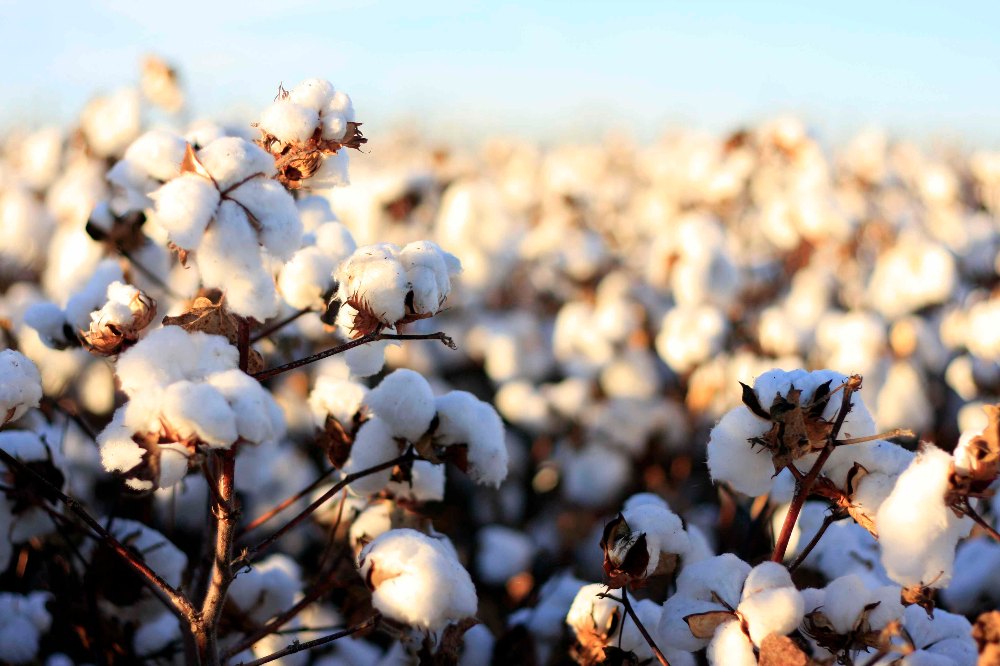
With Western retailers diversifying their sourcing away from China, there is a golden opportunity for India, with its rich textile heritage and a vast cotton-producing base. While India has witnessed encouraging growth in cotton textile exports, the path ahead is fraught with challenges and competitive pressures.
Shifting global trade
The decision by US and EU retailers to reduce reliance on Chinese cotton garments is influence by factors like, including geopolitical tensions, concerns about forced labor in Xinjiang, and a desire for supply chain diversification. This has created a vacuum, which countries like Vietnam and, to a lesser extent, India are attempting to fill.
India's cotton textile exports saw a 20 per cent year-on-year growth (April-December). Texprocil data suggests exports of cotton yarn, fabrics, made-ups, and handloom products grew by 11.98 per cent in December 2024 compared to December 2023. Overall growth for these products during April-December 2024 stood at 2.82 per cent. Apparel exports rose by 11.5 per cent in the same period. China’s market share in US dropped by 1 per cent in 2023 compared to 2022. India's share in the US market inched up by 0.2 per cent to reach 5.9 per cent.
Advantage India
India possesses several advantages, including a large domestic cotton production base; skilled workforce in textile manufacturing; well-established textile industry; government support for the textile industry.
However, India faces significant issues as well. For example, Indian cotton prices are currently higher than those of US cotton, making Indian exports less competitive. The Shankar-6 variety, a benchmark in India, is priced significantly higher than ICE prices. While ICE prices are hovering at 66-68 US cents per pound, Shankar-6 priced at Rs 53,550 per candy.
Table: Cotton’s competitive landscape
|
Country |
Market share (US) |
Key strengths |
Key challenges |
|
China |
Decreasing (20.8%) |
Established manufacturing base, economies of scale |
Geopolitical tensions, rising labor costs, tariffs |
|
India |
5.9% (Increasing) |
Large cotton production, skilled workforce, government support |
Price competitiveness, reliance on domestic market, logistical issues |
|
Vietnam |
Increasing |
Competitive pricing, efficient manufacturing, free trade agreements |
Reliance on imported cotton, potential supply chain vulnerabilities |
|
Bangladesh |
Decreasing |
Large manufacturing capabilities. |
Labor concerns, and over dependence on cotton imports. |
Meanwhile Vietnam's strategy of sourcing cheaper cotton from the US, Brazil, and West Africa gives it a cost advantage. The Indian cotton market is experiencing stagnation, with the Cotton Corporation of India (CCI) actively procuring cotton under the price support program. CCI has procured 92 lakh bales at the MSP. Estimates suggest CCI's procurement may exceed 100 lakh bales.
Kasturi cotton initiative, a game changer?
A significant development that holds immense promise for India's cotton sector is the ‘Kasturi Cotton’ initiative a joint effort by the Ministry of Textiles, the Cotton Corporation of India, and various textile industry stakeholders. The goal is to create a globally recognized Indian cotton brand that embodies quality, reliability, and sustainability.
This program is designed to elevate the status of Indian cotton on the global stage by focusing on. Quality as Kasturi Cotton signifies premium, high-quality cotton that adheres to stringent quality benchmarks. Utilizing blockchain technology, the initiative ensures end-to-end traceability, allowing consumers to verify the origin and quality of the cotton. And the program promotes sustainable cotton farming practices.
The Kasturi Cotton initiative has the potential to significantly impact India's cotton industry in several ways. By establishing a premium brand, India can command higher prices for its cotton, improving the profitability of farmers and textile manufacturers. The emphasis on quality and traceability will make Indian cotton more attractive to international buyers, particularly those seeking sustainable and ethically sourced products. The blockchain technology will enhance transparency and efficiency throughout the cotton supply chain. By following best practice farming, farmers will gain better renumeration for their products.
To capitalize on the current opportunity, India needs to:
Increase price competitiveness: Measures to reduce cotton production costs and improve efficiency are crucial. This may involve investing in better farming techniques, improving seed varieties, and streamlining supply chains.
Boost export infrastructure: Improve logistical efficiency, reduce transaction costs, and enhance port facilities.
Focus on value addition: Move up the value chain by producing high-quality, value-added textile products.
Promote sustainable practices: Embrace sustainable cotton farming and manufacturing practices to meet the growing demand for eco-friendly products.
Leverage government initiatives: Take full advantage of government schemes and incentives aimed at promoting textile exports.
Diversify markets: While the US and EU are key markets, exploring opportunities in other regions is also important.
Adapt to e-commerce changes: The new US tariffs on small parcels from China create an opening. Indian sellers must adapt to these changes and strengthen their presence on e-commerce platforms.
Chinese fashion brand Urban Revivo is making a bold move into Western markets, set to open its first US flagship store in New York’s Soho. The Guangzhou-based retailer, which already has more stores in China than Zara and H&M, plans 25 new outlets outside China this year, including two in London and several in Japan and the Middle East.
Founder Leo Li aims to accelerate overseas expansion, with 100 global stores by next year. To support growth, Urban Revivo is developing a supply chain outside China, starting production in Turkey for Europe and exploring local partners for the US.
Unlike Shein’s online-first strategy, Urban Revivo is betting on physical retail. Many Chinese brands have struggled to gain traction in Western markets, but Li believes leveraging China’s efficient supply chain and e-commerce expertise will give it a competitive edge over Zara and H&M.
Facing slowing domestic demand, Chinese apparel brands are pushing global growth. Li sees Western markets eventually making up 30 per cent of sales. By moving production closer to consumers, Urban Revivo aims to cut costs and stay competitive in fast fashion’s shifting landscape.
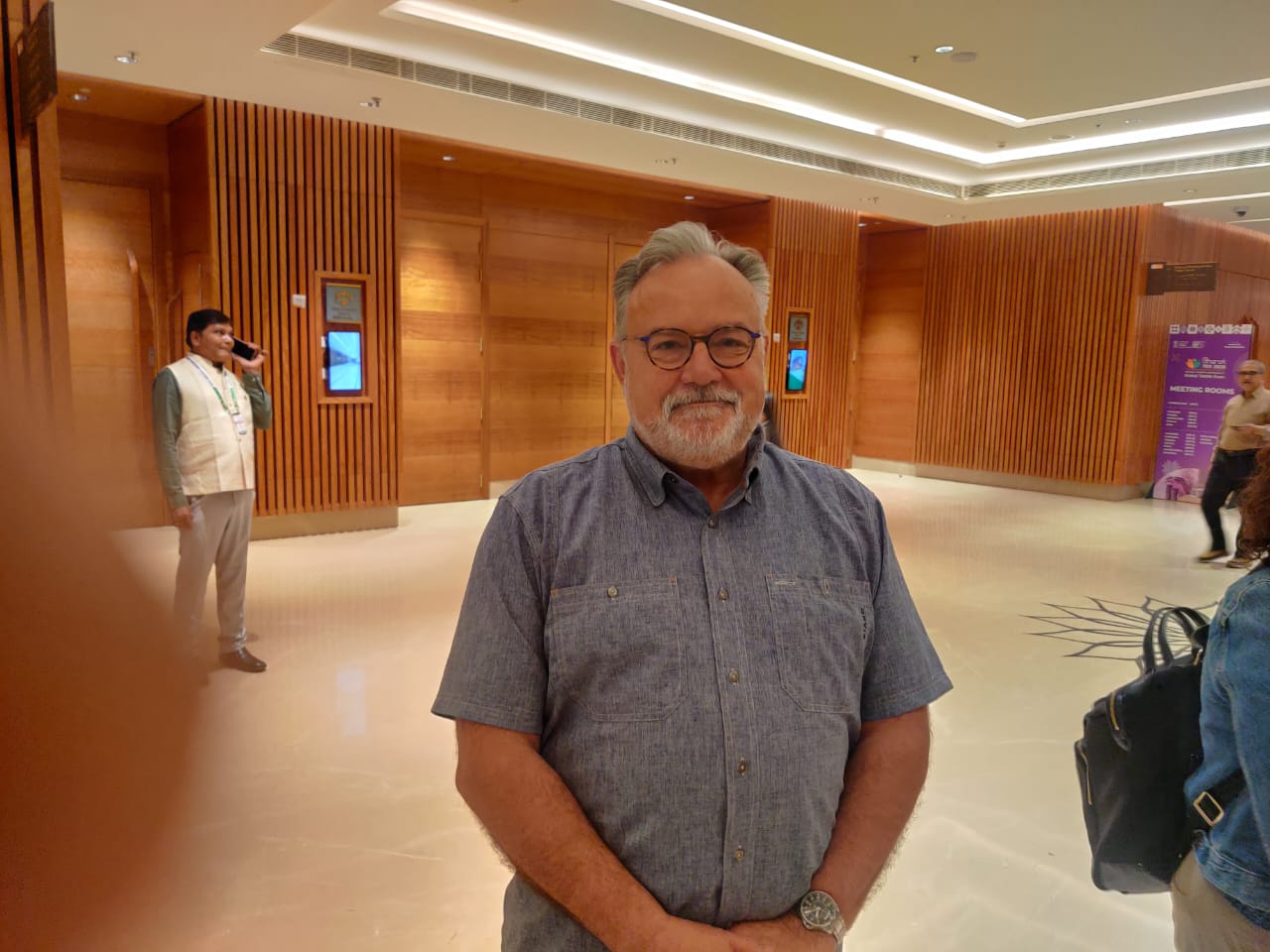
Industry veteran Robert Anthoshak has announced his move to Grey Matter Concepts, where he will serve as Vice President of Global Strategic Sourcing & Development. Anthoshak, who previously served as a consultant at Gherzi Textile Organisation, brings years of experience in the textile and apparel sector to his new role.
"After many fulfilling years as a consultant... I’m thrilled to announce that I am joining Grey Matter Concepts," Anthoshak stated. He aims to leverage his extensive background to bolster Grey Matter Concepts' global sourcing strategies and contribute to the company's growth.
Anthoshak expressed gratitude to his network and looks forward to forging new connections and exploring opportunities in his new position.

Giordano Middle East has been honored with two prestigious awards at Giordano International’s Global Conference in Dongguan, China. The company secured the Best Market Award and the Most Valuable Partner Award for 2024, underscoring its leadership and outstanding performance in the region.
The Best Market Award recognizes Giordano Middle East’s strong business growth, operational excellence, and commitment to customer satisfaction. Meanwhile, the Most Valuable Partner Award highlights its strategic contributions and alignment with Giordano International’s vision of quality, simplicity, and innovation.
Ishwar Chugani, CEO and Managing Director of Giordano Middle East, expressed pride in the achievement: "Winning these awards is a testament to our team’s hard work and dedication. We continually strive to enhance customer experience, expand our market, and uphold the brand’s core values. These accolades inspire us to push boundaries and achieve even greater milestones."
Colin Currie, CEO of Giordano International, also praised the Middle East team: "Giordano Middle East consistently excels in operations, customer engagement, and market expansion. Their ability to innovate and deliver outstanding results is truly commendable. These awards reflect their unwavering commitment to the brand’s success."
With a strong presence across the region, Giordano Middle East continues to deliver high-quality apparel and an exceptional shopping experience. These awards reinforce its role in the brand’s global success and commitment to excellence.
Founded in Hong Kong in 1981, Giordano is a global apparel brand offering timeless fashion for all. Embracing diversity, it connects people worldwide with its “World Without Strangers” philosophy.

In a move to boost bilateral trade relations with the US, India is contemplating significant tariff reductions on labor-intensive sectors, including gems and jewellery, automobile parts, and textiles. This initiative aligns with the ‘Mission 500’ goal that seeks to double bilateral trade to $500 billion by 2030.
As per Indian government sources, the easing of tariffs would be reciprocated by the US, likely targeting reductions on its industrial goods exports to India. "The focus is on sectors that are highly dependent on manpower for production, which includes engineering goods," stated a government official familiar with the negotiations.
Gains for textile sector
India currently imposes varying customs duties on exports crucial to these sectors: gold and silver, essential for gems and jewellery, face a 6 per cent tariff, while engineering goods encounter duties ranging from 7.5 per cent to 10 per cent. Ready-made garments, a significant segment of the textile industry, are subject to tariffs as high as 20 per cent, or a combination there of.
Recent bilateral merchandise trade figures underscore the importance of these sectors in India's export landscape. From April to November 2024 alone, India exported $59.93 billion worth of goods to the US, with engineering goods leading at nearly $14 billion, followed by gems and jewellery at approximately $7 billion, and ready-made garments at $3.8 billion.
The textile and apparel sector, a significant employer in India, stands to gain substantially from reduced tariffs. Currently, Indian ready-made garments face either a 20 per cent tariff or a complex mix of duties in the US market. The proposed trade deal could provide a crucial competitive edge, enabling Indian manufacturers to expand their market share.
While specifics of the tariff adjustments are still being finalized, the Finance Ministry has already initiated steps to rationalize customs duties, a move expected to benefit American exports significantly. This aligns with broader goals set during Prime Minister Narendra Modi's recent visit to the US, where pledges were made to deepen economic ties and streamline supply chain integration.
Table: Indian Exports to the US (April-Nov 2024)
|
Sector |
Export value ($ bn) |
|
Engineering Goods |
$14.0 |
|
Gems and Jewellery |
$7.0 |
|
Ready-made Garments |
$3.8 |
Table: Tariff overview on key Indian exports
|
Product Category |
Current tariff (%) |
|
Gold and Silver (Inputs) |
6 |
|
Engineering Goods |
7.5 – 10 |
|
Ready-made Garments |
Up to 20 |
In addition to goods, discussions have also touched upon increasing trade in agricultural products, although details on tariff reductions in this sector are yet to be determined.
The forthcoming negotiations are anticipated to pave the way for a more integrated trade framework between India and the US, leveraging mutual strengths in manufacturing and consumption. As both nations prepare to embark on this ambitious trade pact, stakeholders in the textile and apparel sectors are cautiously optimistic about the potential for expanded market access and reduced trade barriers.
Benefits for textile sector
The proposed Bilateral Trade Agreement (BTA), with a focus on tariff reductions, presents a significant opportunity for the Indian textile and apparel sector. Tariff reductions will lead to increased export volumes to the US. It will also lead to higher competitiveness against other exporting nations. Job creation within India's textile and apparel industry will rise and the policy move will also attract foreign investment in the sector while strengthening of the textile and apparel supply chain.
However, the final contours of the deal, including specific tariff lines and concessions, are yet to be determined. Both India and the US have pledged to finalize the first tranche of the BTA by fall 2025. As negotiations progress, the textile and apparel industry will be closely monitoring developments, anticipating a favorable outcome that can drive growth and create new opportunities.
Addressing a challenge arising from a new EU directive mandating waste separation including textiles, Warsaw has introduced mobile selective collection points for textile waste at 42 locations across the city.
In recent months, many Poles have expressed concerns that local authorities were unprepared for the requirements of Directive (2018/851), which took effect on January 1, 2025, and requires EU member states to implement a selective collection system for textiles.
The new rules for separating textiles and shoes are aimed at greener waste management. Shoes, clothing, and other textiles must be disposed of at designated collection points, not in regular garbage bins. Non-compliance can result in fines.
Local governments are responsible for implementing the law and must provide residents with proper disposal options via local selective waste collection points (PSZOK). However, municipalities are not required to collect these items directly from households, and the new containers are not universally available.
The lack of containers has prompted some people to seek ways to circumvent the new rules, sharing online ideas to dispose of used clothing in mixed waste bins, such as soaking items in oil.
From March this year, Warsaw residents can drop off used textiles at Mobile Selective Municipal Waste Collection Points. These points are available at 42 locations citywide on specific days.
According to City Hall, used clothing and textiles unsuitable for reuse will be properly processed, reducing landfill waste.
Addopting a different approach, Lodz installed 50 containers for used clothing and textiles by January-end. The City Council has partnered with a company for free collection, sorting, and recycling textile waste. The first container was placed on Piotrkowska Street in early January.
Failure to comply with segregation regulations can result in fines. Municipal police and bailiffs may impose fines up to 5,000 Zloty (€1,200) on property owners who violate local waste management rules. Disposal fees may also increase if textiles are found in mixed waste.
Giorgio Armani closed Milan Fashion Week with two signature fashions shows, staged in a set designed like an upscale nightclub.
Beginning with a daywear collection, Armani showcased a series of diverse trousers—harem, palazzo, dhoti, and revamped jodhpurs—paired with zigzag blazers or his signature demi-wrapped blouse. He also incorporated ikats into bomber jackets, as singular elements, and even on suede booties.
Armani also presented a notable collection headgear including Nehru caps, Balinese musician skullcaps, Javanese Blangkon, Thai Khian Hua, and Singaporean Mandarin caps. Eclectic yet refined, each folkloric design was elevated to elegance.
The eveningwear collection featured a dozen striking silver looks including shimmering crystal lattices in columns, slimline cloaks, and veiled gowns. The collection included a midnight blue speckled silk trouser suit exemplifying perfection.
Encapsulating Armani's signature elements including classical proportions, artful draping, feather-light fabrics, diverse Asian influences, and a distinct color palette. The collection demonstrated his unwavering commitment to his origins.
For the next fall seaons, he aims to transition to a collection featuring Indochinese ikat tones, and conclude with silvery Hollywood glamour.
This season, Armani aligned with Milan's trend of treating shearling like exotic fur as was seen in pale gray ribbed pony-skin jerkins and brown-trimmed dusters by the designers.
Investors and analysts believe, Adidas's ability to attract more American shoppers away from market leader Nike will be crucial for its continued success this year, as the German brand seeks new growth sources beyond its popular Samba and Gazelle sneakers.
With uncertainty surrounding consumer demand recovery in China, many brands, including those in the luxury sector, are focusing more on US shoppers as a key growth driver for 2025.
Bjorn Gulden, CEO has been successful in revitalizing Adidas since the brand severed ties with rapper Ye and discontinued its lucrative Yeezy sneaker range in October 2022.
Investors expect Gulden to outline how Adidas plans to continue gaining market share from Nike while also competing with emerging sportswear brands like On Running and Hoka when it reports full-year results on March 5.
Nike's share in the global sportswear market share declined 14.1 per cent last year from 15.2 per cent in 2023, according to GlobalData. On the other hand, Adidas's market share increased to 8.9 per cent from 8.2 per cent, with gains also seen by New Balance, On Running, and Hoka.
According to UBS analysts, European brands have historically struggled to compete in the US, and North America has been a lagging region for Adidas recently, though they anticipate this trend reversing.
Adidas's North American sales, that declined by 7 per cent in Q3,FY24, from the previous year, have not fully recovered from the end of the Yeezy line, which was particularly popular in the US.
Overall, Adidas sales grew by 19 per cent during the quarter, and 12 per cent for the full year 2024, while Nike's sales declined by 9 per cent in its latest quarter ending November 30, 2024.
Currently, there’s a huge gap between Adidas and Nike growth, says, Thomas Jökel, Portfolio Manager, Union Investment, which holds Adidas shares.
Adidas's overall sales will continue to grow by at least 10 per cent annually as long as Nike faces challenges, adds Jökel, emphasizing, the US and broader North American market are key growth areas.
Actively targeting US consumers, Adidas recently launched an apparel and shoe collection inspired by ‘collegiate Americana’ in collaboration with Los Angeles-based label Sporty & Rich, and a new Superstar 92 sneaker collection with American musician and designer Pharrell Williams.
The brand has also signed Satsou Sabally, WNBA Player and Travis Hunter, College Football Player, as brand ambassadors.

